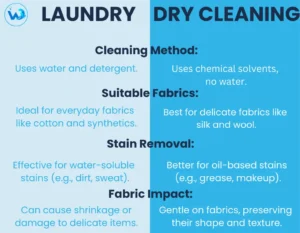Best Laundry & Dry Cleaning Services
Introduction
In today’s fast-paced world, keeping your wardrobe in pristine condition can be a challenge. Whether you’re dealing with delicate silks, everyday cotton, or stubborn stains, finding a laundry service that truly cares for your clothes is essential. But with so many options out there, how do you choose the best one? This article uncovers the top laundry and dry cleaning services that not only deliver spotless results but also go the extra mile to protect your garments and the environment. If you’re looking for convenience, quality, and a touch of luxury in garment care, you’re in the right place.
Laundry Services by Wash House
Wash House has become a popular choice for many people seeking quality laundry services. They offer a range of options to meet different needs, from basic washing and folding to specialized care for delicate garments. Wash House takes pride in ensuring that every item is treated with care and attention.
The Expertise of Wash House in Spotless Results
Wash House is known for delivering spotless results. Their skilled team is trained to handle various fabrics and stains, ensuring your clothes look fresh and clean. Whether it’s a tough stain or a delicate fabric, Wash House has the expertise to deal with it.
Laundry and Dry Cleaning at Your Convenience
Convenience is a major factor when choosing a laundry service, and Wash House excels in this area. They offer pickup and delivery services, so you can have your laundry taken care of without leaving home.
Wash House’s Commitment to Eco-Friendly Practices
In today’s environmentally conscious world, Wash House stands out with its eco-friendly approach. They use biodegradable detergents and energy-efficient machines, reducing their environmental impact while still delivering high-quality results.
Raising the Bar in Garment Care
Wash House goes beyond just cleaning clothes—they aim to elevate garment care standards. They understand that different fabrics require different care, and they ensure that each garment is treated according to its specific needs.
Customized Services to Meet Your Needs
Wash House recognizes that every customer has unique needs. Whether you need hand washing or special care for delicate fabrics, they offer personalized services to ensure your garments are treated exactly how you want.
Wash House’s Affordable Pricing
Price is an important consideration when choosing a laundry service, and Wash House offers competitive rates without sacrificing quality. Their pricing is transparent, with no hidden fees, so you know exactly what to expect.
High Customer Satisfaction
Customer satisfaction is a top priority for Wash House. With many repeat customers and positive reviews, their reputation speaks for itself, reflecting the quality and reliability of their services.
Innovation at Wash House
Innovation is at the heart of Wash House’s services. They continually invest in the latest technology and techniques to improve their services, ensuring that customers get the best care for their clothes.
Advanced Laundry Machines and Dry Cleaning Processes
Wash House uses the latest laundry machines and dry cleaning techniques, designed to be both efficient and effective. Their equipment can handle a wide range of fabrics and stains, ensuring thorough cleaning without damaging your clothes.
Safe and Effective Dry Cleaning Chemicals
Choosing the right dry cleaning chemicals is crucial for maintaining the quality of your clothes. Wash House uses gentle but effective solvents that clean your garments without compromising the fabric.
The Advantages of Dry Cleaning
While traditional home washing is suitable for most everyday clothes, dry cleaning offers distinct advantages for specific garments:
- Preserves Delicate Fabrics: Dry cleaning employs a gentler approach for delicate fabrics like silk, wool, and cashmere. This prevents shrinkage and distortion that can occur with water washing.
- Superior Stain Removal: Dry cleaning solvents are often more effective at removing oil-based stains, grease, and certain types of ink that water struggles to tackle.
- Maintains Shape and Structure: Dry cleaning helps garments retain their original shape and structure, particularly important for tailored clothing and structured garments.
- Extends Garment Lifespan: By using a gentler cleaning method, dry cleaning can significantly extend the lifespan of your delicate items.
- Eliminates Persistent Odors: Dry cleaning effectively removes smoke, sweat, and other stubborn odors that can linger after washing with water.

Navigating Dry Cleaning Like a Professional
Here are some key pointers to optimize your dry cleaning experience:
- Decipher the Care Label: Always consult the care label on your garment. This label will specify whether dry cleaning is recommended or if hand-washing is a viable option.
- Pre-Treat Stains Promptly: If you notice a stain before sending your garment for dry cleaning, pre-treat it with a stain remover following the care label instructions.
- Empty Pockets Thoroughly: Ensure all contents are removed from your pockets before dry cleaning.
- Turn Delicates Inside Out: Turning garments inside out before dry cleaning can help minimize wear and tear.
- Communicate with Your Dry Cleaner: If you have any specific concerns about a garment, don’t hesitate to speak with your dry cleaner beforehand. They can advise you on the best cleaning method for your specific needs.
Conclusion
In conclusion, Wash House is one of the top choices for laundry and dry cleaning services. Their dedication to quality, customer satisfaction, and eco-friendly practices makes them an excellent option for anyone looking to keep their clothes in great condition. Whether you need regular laundry services or specialized care for delicate garments, Wash House offers everything you need.
Frequently Asked Questions About Dry Cleaning
Is dry cleaning expensive?
Dry cleaning costs can vary depending on the size and type of garment, the dry cleaner you use, and any additional services required. Generally, it’s more expensive than washing clothes at home.
Is dry cleaning safe for all fabrics?
Dry cleaning is safe for most fabrics, but some materials may be damaged by the process. Always check the care label before deciding.
How often should I dry clean my clothes?
The frequency of dry cleaning depends on how often you wear the garment and the type of fabric. Delicate items like suits might need dry cleaning after every few wears, while other garments can go longer.
Can I dry clean at home?
Yes, there are home dry-cleaning kits available, but they may not be as effective as professional services, especially for heavily stained or delicate items.
What are the alternatives to dry cleaning?
Eco-friendly alternatives include wet cleaning and using CO2-based solvents. These methods are less harmful to the environment and can be just as effective.
Does dry cleaning shrink clothes?
Dry cleaning typically does not shrink clothes, making it a good option for items that are prone to shrinkage in water.
Which is better: dry cleaning or laundry?
It depends on the fabric and the type of stain. Dry cleaning is often better for delicate fabrics and oil-based stains, while laundry is typically used for everyday clothing.
Why are some polyester dresses labeled “dry clean only”?
Some polyester dresses are labeled “dry clean only” because the fabric can shrink or lose its shape if washed in a regular washing machine.
Can dry cleaning remove stains?
Yes, dry cleaning is effective at removing many types of stains, especially oil-based stains that regular washing might not fully remove.
What kind of clothes need dry cleaning?
Clothes made from delicate fabrics like silk or wool, or garments with intricate details, generally need dry cleaning to maintain their quality.
Is it better to dry clean black clothes to prevent fading?
Dry cleaning is often recommended for black clothes because it helps preserve the color and prevents fading that can occur with regular washing.
